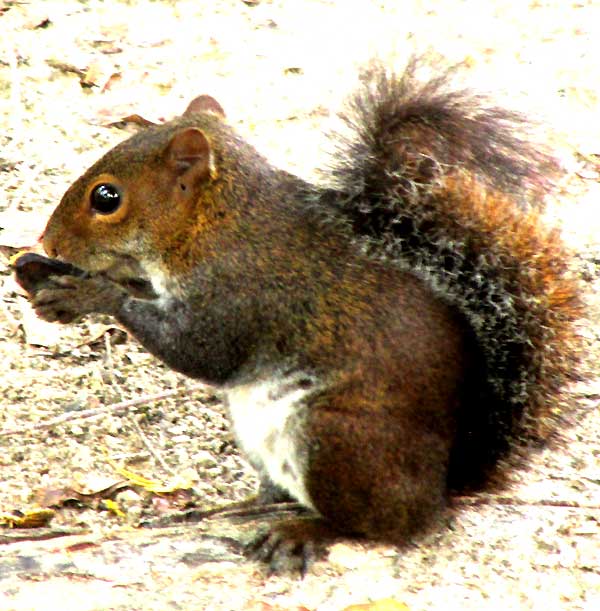Excerpts from Jim Conrad's
Naturalist Newsletter
from the April 12, 2019 Newsletter with notes from a camping trip into the Petén distric of northern GUATEMALA
DEPPE'S SQUIRREL

Last September during my camping trip into northern Guatemala's Petén Department, the first day I checked into the campground at El Rosario National Park on the west side of the town of Sayaxché, I was tickled to see squirrels scurrying about. Might these be a species new for me? In the Mexican state of Chiapas, across the Usumacinta River from the Petén, I'd already identified Red-bellied Squirrels, which you can see at www.backyardnature.net/q/squirrel.htm
Yucatan Squirrels also appear in the area, shown at www.backyardnature.net/yucatan/squ_gray.htm
Unfortunately the squirrels in El Rosario's campground were nervous creatures and last year I never did get close enough to one for a good picture. During my return visit to El Rosario a couple of weeks ago, I was determined to get a good squirrel shot.
The campground still had its squirrels, and still I couldn't get a good shot of one. They'd descend a tree on the trunk's side opposite to me, then shoot like a bullet across the open area to the next trunk, and ascend that tree again on the opposite side of the trunk. I gave up.
On my last day in the campground, on April 3rd, I passed by the park's office building, inhabited full time by several officials and works, and there on the ground about 20 feet from where the fellows liked to hang out, was a squirrel nibbling on something that one of the fellows must have tossed it. That squirrel is shown atop this page.
The squirrel's most conspicuous field mark doesn't register in the photo, because in the image you can't judge the animal's size. It was the smallest adult-looking squirrel I'd ever seen.
On the Internet, when all the eligible species for the Petén area were looked at, this squirrel's pattern of rusty and gray fur matched most closely the Deppe's Squirrel, SCIURUS DEPPEI, distributed from southern and eastern Mexico south through Central America to northern Costa Rica.
A description of Deppe's Squirrel by Troy Best, in the October, 1995 issue of Mammalian Species, published by The American Society of Mammalogists, describes the species as 343-387mm long. The Yucatan Squirrel is 450-500mm long, and the Red-bellied Squirrel is 418-573mm long.
The size and color pattern, then, indicate the Deppe's Squirrel, and there's no reason why that species should not be in El Rosario National Park. In fact, the Wikipedia page for the Deppe's Squirrel reports that in nearby Tikal National Park, populations of this species are commonly seen around the Mayan Ruins. A study of the Deppe's Squirrel population in Tikal National Park, by Lori Hiding, freely available on the Internet, documented more concentrated populations of Deppe's Squirrels around the ruins than under more natural conditions.
In general, Deppe's Squirrels eat similar foods and behave like other tree squirrels. One peculiarity of them is that females in most species of the genus Sciurus bear four pairs of mammary glands, but Deppe's Squirrels have only three pairs.